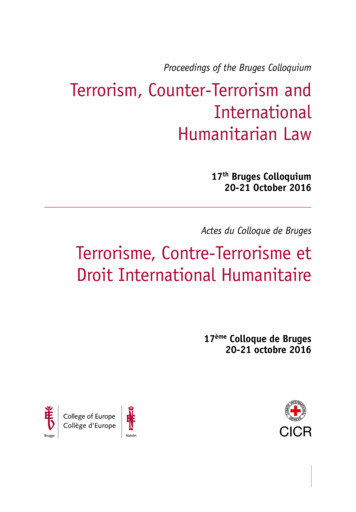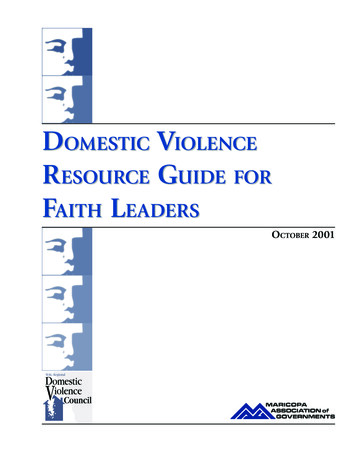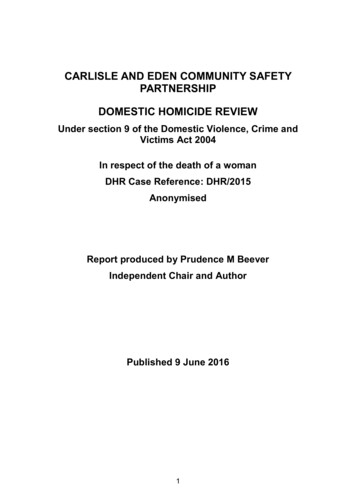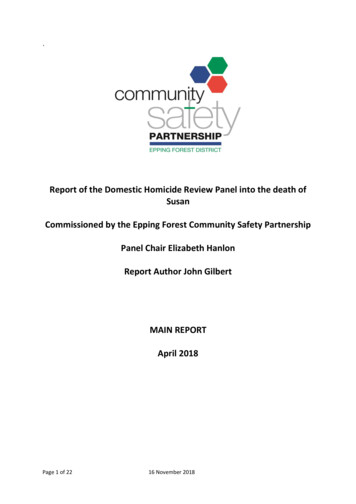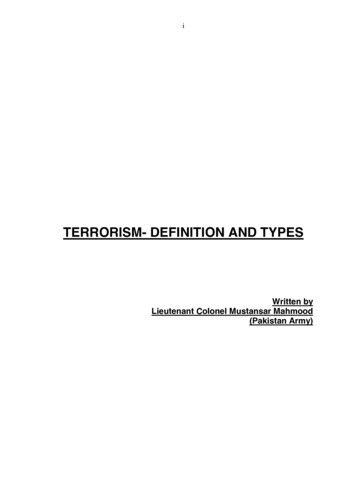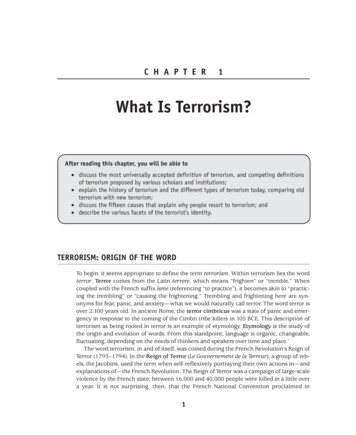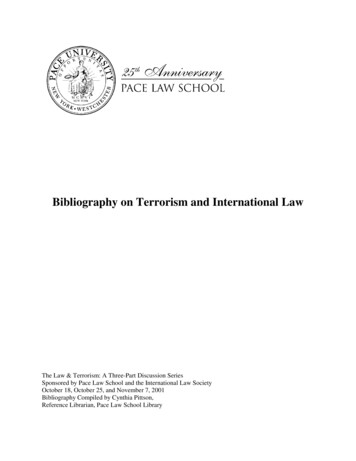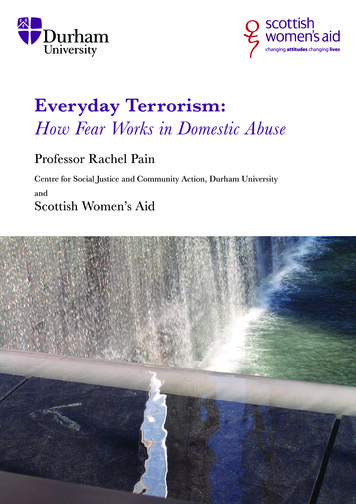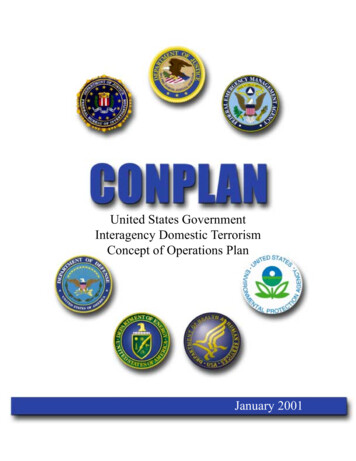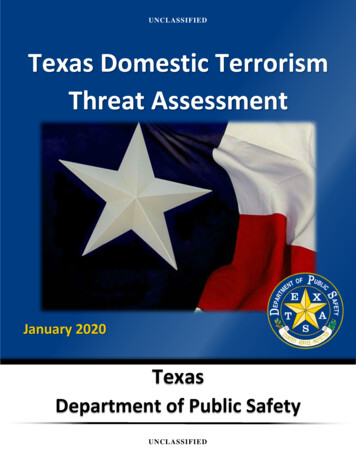
Transcription
UNCLASSIFIEDTexas Domestic TerrorismThreat AssessmentJanuary 2020TexasDepartment of Public SafetyUNCLASSIFIED
UNCLASSIFIEDTexas Domestic Terrorism Threat AssessmentA State Intelligence EstimateProduced by the:Texas Fusion CenterIntelligence & Counterterrorism DivisionTexas Department of Public SafetyIn collaboration with federal, state, and local law enforcement and criminal justice agenciesJanuary 2020This report is the UNCLASSIFIED version of an original report containing Law Enforcement Sensitive information.All information and citations from the original report that are confidential by law or excepted from public disclosurerequirements have been redacted from this unclassified version. In some cases, the original Law EnforcementSensitive citations have been replaced with citations to public sources that serve as alternative references.UNCLASSIFIED1
UNCLASSIFIEDTHIS PAGE INTENTIONALLY LEFT BLANK2UNCLASSIFIED
UNCLASSIFIED(U) Executive Summary(U) The key analytic judgments of this assessment include: (U) Domestic terrorism poses a persistent and varied threat to the State of Texas. There arethree overall types of domestic terrorism: racially motivated, anti-government, and single issue.Each type contains further subsets, creating a fair amount of variance within this threat. Texas hasprevious or current activity associated with each of these types of domestic terrorism. Thisincludes the recent loss of 22 lives when a suspected domestic terrorist opened fire in an El Paso,Texas Walmart. (U) Based on the prevalence of recently conducted attacks nationwide, White RaciallyMotivated (WRM) is currently the most violently active domestic terrorism type. Since2018, WRM actors were responsible for at least three major attacks in the United States(including one in Texas), and several thwarted incidents. This activity outnumbered the otherdomestic terrorism types. While other types of domestic terrorism have shown threatening andforceful behavior, the loss of life from recent WRM attacks elevates the nature of this specificthreat. (U) Although not a new movement, Involuntary Celibates (Incels) are an emerging domesticterrorism threat as current adherents demonstrate marked acts or threats of violence infurtherance of their social grievance. Once viewed as a criminal threat by many lawenforcement authorities, Incels are now seen as a growing domestic terrorism concern due to theideological nature of recent Incel attacks internationally, nationwide, and in Texas. What beginsas a personal grievance due to perceived rejection by women may morph into allegiance to, andattempts to further, an Incel Rebellion. The result has thrust the Incel movement into the realm ofdomestic terrorism. The violence demonstrated by Incels in the past decade, coupled withextremely violent online rhetoric, suggests this particular threat could soon match, or potentiallyeclipse, the level of lethalness demonstrated by other domestic terrorism types. (U) Shifts in domestic terrorism activity can occur quickly and frequently, depending onchanges in political or social circumstances, requiring law enforcement to remain alert to allforms of potential domestic terrorism. Because domestic terrorism requires a political or socialmotivation, the potential for changes in these areas to produce quick swings in activity remainshigh. Events such as elections, new legislation, and social justice-related incidents all have thepotential to spark activity in previously dormant movements, or see the emergence of newdomestic terrorism actors. Since all domestic terrorism types have a presence in Texas, it isnecessary for Texas-based law enforcement to maintain situational awareness across this threatspectrum. (U) Digital media both facilitates radicalization/recruitment, inspiration, andcommunication between domestic actors, and allows greater involvement by internationalelements in domestic terrorism. Digital media platforms are powerful tools domestic terroristsuse to spread their message to a wide audience. These platforms allow global opportunities topost manifestos, live stream attacks, and seek inspiration. They also provide opportunities foractors with similar beliefs to communicate internationally. A number of recent events highlight atrend of U.S. domestic terrorists seeking inspiration or training from foreign actors, and foreignbased individuals in turn finding inspiration in attacks occurring in the United States.UNCLASSIFIED3
UNCLASSIFIED4 (U) Many domestic terrorism actors intentionally attack soft target locations, threateningthe public’s sense of wellbeing and security. A number of recent domestic terrorism attacksoccurred at soft target locations, and several involved an attacker actively advocating for others tofollow their example. Many domestic terrorism actors favor soft targets, including large,defenseless populations and symbolic representations of something that actor opposes.Additionally, successful attacks against soft targets can have a demoralizing effect on a targetedpopulation, instilling fear of everyday tasks. (U) The lack of a chargeable federal or state domestic terrorism statute makes it difficultfor law enforcement to investigate, prosecute, and track overall domestic terrorism trends.Presently there is no chargeable offense for domestic terrorism at the federal or state level inTexas. Although there is a federal statute defining domestic terrorism, it does not include anydomestic terrorism offenses. Thus, for the purposes of investigation and prosecution, lawenforcement must rely on a variety of other criminal offenses such as murder, arson, fraud, hatecrime, or assault. This complicates the ability for law enforcement agencies to track domesticterrorism incidents, and therefore trends, within a given jurisdiction. (U) Decentralized, leaderless domestic terrorism movements, coupled with the potential forblurred motivations or blended ideologies, challenge law enforcement to accurately identifydomestic terrorism actors and prevent future attacks. The individualistic nature of recentdomestic terrorism attackers challenges law enforcement to identify these actors prior to anincident occurring. An individual may choose not to share potential plans with anyone, and issueonly vague threats prior to launching their attack. Additionally, as witnessed in several recentattacks, the individual involved may ascribe to a blurred or blended ideology. This not onlychallenges the identification of that actor as a domestic terrorist, but it can complicate identifyingpotential targets before an attack occurs.UNCLASSIFIED
UNCLASSIFIED(U) Table of Contents(U) Executive Summary . 3(U) Table of Contents . 5(U) Acknowledgements . 7(U) Introduction . 11(U) Domestic Terrorism – Distinguishing the Threat . 11(U) Grouping Types of Domestic Terrorism . 13(U)Racially Motivated . 15(U) White Racially Motivated Terrorism. 15(U) Black Racially Motivated Terrorism . 19(U)Anti-Government . 23(U) Militias. 23(U) Sovereign Citizens . 24(U) Anarchists . 25(U) Single Issue. 27(U) Types of Single Issue Actors . 27(U) Symbology and Organization . 31(U)Challenges to Law Enforcement . 35(U) Legal Considerations . 35(U) Challenges Related to Attributes of Domestic Terrorists . 36(U) Digital Media Collection Challenges . 38(U) Outlook . 39(U)Appendix A: State Intelligence Estimates . 41(U)References . 43UNCLASSIFIED5
UNCLASSIFIEDTHIS PAGE INTENTIONALLY LEFT BLANK6UNCLASSIFIED
UNCLASSIFIED(U) Acknowledgements(U) The Texas Fusion Center collaborated with law enforcement and criminal justice agencies acrossTexas and the United States in the production of this State Intelligence Estimate. Their contributions wereinvaluable to developing an accurate and complete assessment of the domestic terrorism threat in Texas.These contributions underscore the commitment among agencies across Texas and the United States toshare information, intelligence, and capabilities to address public safety threats across all jurisdictions anddisciplines at all levels. We are grateful to the numerous agencies that contributed to this assessment.UNCLASSIFIED7
UNCLASSIFIEDTHIS PAGE INTENTIONALLY LEFT BLANK8UNCLASSIFIED
UNCLASSIFIED(U) Preface(U) On August 14, 2019, in the aftermath of the domestic terrorism attack in El Paso, Texas, GovernorGreg Abbott directed the Texas Department of Public Safety (DPS) to work with local, state, and federalpartners to produce a state intelligence assessment on the threat of domestic terrorism in Texas. DPS issubmitting this report in response to that directive.(U) There is no consensus on the definition of domestic terrorism. For the purposes of this report,domestic terrorism is the furtherance of political or social goals by U.S.-based individuals or groups,through acts or threats of force or violence, and in violation of criminal law. This definition closely alignswith those used by federal law enforcement agencies.(U) The Texas Fusion Center produced this assessment in the form of a State Intelligence Estimate. Itincludes the contributions of a wide range of law enforcement, criminal justice, and government agenciesin the state and throughout the United States.(U) The statements, conclusions, and assessments included in this report were reached based on a reviewand analysis of information from a variety of sources, including federal, state, and local reports of varyingdegrees of sensitivity and reliability, and open-source reporting.UNCLASSIFIED9
UNCLASSIFIEDTHIS PAGE INTENTIONALLY LEFT BLANK10UNCLASSIFIED
UNCLASSIFIED(U) Introduction(U) On August 3, 2019, shortly after 10:30 a.m., a man opened fire at a Walmart in El Paso, Texas. Hisaction would eventually take the lives of 22 individuals and injure another 26. Just prior to the attack, thesuspected shooter, Patrick Crusius, allegedly posted a manifesto online. The document contained rhetoricfilled with anger and hate, including extreme beliefs based on race and ethnicity. Only minutes after themanifesto appeared online, Crusius went from extreme belief to violent, forceful action.(U) The tragedy in El Paso highlights the potential growth of a persistent threat: domestic terrorism. Thisdocument will examine the current domestic terrorism threat posed to Texas, providing an overview ofthe types of ideologies and motivations that exist in this threat realm. Because any analysis of domesticterrorism requires a discussion of ideology, the subject is understandably sensitive. Americans enjoy aprofound freedom, codified in the First Amendment, which protects expression of belief, even when suchexpression may be repugnant to mainstream ideals. Therefore, discussion of belief, opinion, or ideology isonly included in this document to provide context when the threat or application of criminal behavior,force, or violence in furtherance of a political or social goal exists.(U) Domestic Terrorism – Distinguishing the Threat(U) Defining domestic terrorism is challenging, owing in part to the lack of a distinct, chargeable offensedistinguishing domestic terrorism from other criminal acts. However, the term typically involves threecomponents: a U.S.-based individual/group; force or violence; and the presence of a political or socialgoal. Therefore, for the purposes of this report, domestic terrorism is “the furtherance of political or socialgoals by U.S.-based individuals or groups through acts or threats of force or violence, and in violation ofcriminal law.”(U) Past and present ambiguity in defining and distinguishing domestic terrorism creates a number ofchallenges to the analysis of this threat. First, depending on the definition used, there is the potential fordomestic terrorism to become confused with other significant, but distinct, threats to the homeland. Forexample, like domestic terrorists, Homegrown Violent Extremist (HVE) actors are U.S.-based individualswho may engage in violent activities to further a political or social goal. However, HVEs are distinct fromdomestic terrorists in that, typically, a designated foreign terrorist organization (FTO) inspires theiractions.a(U) A similar concern is the potential conflation of domestic terrorism with mass attack or serial attackevents that contained no ideological component. Mass attack or serial attack events can terrorize acommunity, and often result in significant injury or loss of life. However, in cases where no ideologicalmotivation is present, mass and serial attackers are distinct from domestic terrorists in that their actionsare not seeking to further a political or social goal.1 A notable recent example of this occurred in the formof the “Austin Bomber.” For most of March 2018, Mark Anthony Conditt terrorized the greater Austin,Texas area with a series of explosive devices placed in random locations over the course of severalweeks.2 The devices killed two and injured another five before Conditt eventually killed himself during aconfrontation with law enforcement. Despite the horrific nature of Conditt’s actions, there remains noindication of a political or social motivation. Thus, while Conditt qualifies as a serial attacker, he may notfit the definition of a domestic terrorist.3a(U) The FBI, U.S. Department of Homeland Security (DHS), and National Counterterrorism Center (NCTC) define a HVE as aperson of any citizenship who lives or operates primarily in the United States or its territories, and who advocates, engages in, oris preparing to engage in or support terrorist activities in furtherance of a foreign terrorist organization’s objectives, but who isacting independently of foreign terrorist direction.UNCLASSIFIED11
UNCLASSIFIED(U) An additional challenge in analyzing the domestic terrorism threat is the inability to identify trendsthrough quantitative data. There is no finite dataset that can clearly show an increase or decrease in acts ofdomestic terrorism, or the number of domestic terrorists. Any attempt to count the number of U.S.-basedindividuals harboring domestic terrorist beliefs presents significant civil liberties concerns. Unlike supportfor designated FTOs, the legality of which is clearly defined by 18 U.S. Code § 2339B, much of theactivity or expression exhibited by domestic terrorists leading up to a potential event is protected by theFirst Amendment. Additionally, legal considerations often result in the prosecution of domestic terroristsunder a variety of non-terrorism charges, such as hate crimes or weapons violations. Thus, it is virtuallyimpossible to provide a number of individuals prosecuted as domestic terrorists.(U) Differentiating Between Extreme and Mainstream(U) Historically, governmental entities have sought to mitigate issues with defining domestic terrorism byinserting the word “extremism” in the place of “terrorism.” 4 The term extremism may allow for moreflexibility in describing or even prosecuting criminal, but non-violent, behavior associated with domesticterrorist groups or ideologies. However, the mixing of these two terms can occasionally create definitionalconfusion. Therefore, for the purposes of this document, “extreme” applies to a description of anindividual’s or group’s view towards force and violence.(U) Rather than attempting to define domestic terrorism as an extreme application of a mainstreampolitical belief, it is easier to distinguish domestic terrorists from mainstream individuals by the fact thatthey believe force or violence is an acceptable means to accomplish their goals. This may include thosewho justify force against property or infrastructure as a valid means to an end, those who justify the use ofviolence against people, or individuals who believe both are justified. While no actual percentage existsfor domestic terrorists, an implicit assumption in the extreme nature of their beliefs is that they make up asmall portion of the population.(U) Graphic visualizing the different types of populations based on beliefs in use of force and violence.12UNCLASSIFIED
UNCLASSIFIED(U) Grouping Types of Domestic Terrorism(U) While domestic terrorists share a willingness to use force or violence in furtherance of their goals,distinct differences exist in domestic terrorism motivations. These divisions help delineate domesticterrorism types into three main groups: racially motivated, anti-government, and single issue.Understanding the unique nature of these types allows for a more holistic awareness of the overalldomestic terrorism threat.(U) For the purposes of this report, the following definitions apply to the three domestic terrorism types: (U) Racially motivated: An individual or group who displays or threatens force or violencemotivated by a bias against a single or multiple racial and/or ethnic populations;(U) Anti-government: An individual or group who displays or threatens force or violencemotivated by a rejection of governmental authority, a perceived governmental injustice, or beliefthe government has failed in one or more of its duties;(U) Single issue: An individual or group who displays or threatens force or violence motivated bya single, typically social, goal or grievance.(U) These domestic terrorism types provide a basic understanding when considering the threat posed by aparticular actor or group. However, when considering any actor or group it is important to take intoaccount the specific ideology involved. Many who adhere to ideologies encompassed within these typesmay add their own nuances or combine ideologies in their own unique way. Additionally, these domesticterrorism type definitions do not preclude an individual or group from carrying secondary motivationsthat may be of equal concern. For example, there are ideologies that exist touting both racially motivatedand anti-government sentiments.UNCLASSIFIED13
UNCLASSIFIEDTHIS PAGE INTENTIONALLY LEFT BLANK14UNCLASSIFIED
UNCLASSIFIED(U) Racially Motivated(U) Racially motivated actors and groups are those who threaten or use force or violence based on a biasagainst one or more racial or ethnic populations. Often this manifests from a perceived superiority of asingle race or ethnicity over others. This particular domestic terrorism type is further broken down intotwo overarching sub-groups: white racially motivated and black racially motivated. Both sub-groups tracetheir roots to the post-Civil War Era with a resurgence in the mid-20th Century.(U) White Racially Motivated Terrorism(U) WRM domestic terrorism (DT) movements, individuals, and organizations find their roots in twocentral tenets: belief in the superiority of the white race and dominance of non-whites through violence.Historically, motivations for these actors include religious and socially- or culturally-based beliefs.5While the Ku Klux Klan (KKK) and neo-Nazis were the 20th Century face of WRM actors, the currentface of the movement is finding a home in emergent anti-civil rights and anti-equality groups. Althoughthere is considerable overlap in beliefs and motivations, WRM individuals generally fall into two maindelineations: white supremacists or white nationalists. Colloquially, many use these two termsinterchangeably. However, there is a distinct difference between the two best seen in their dictionarydefinitions: (U) White supremacist: a person who believes that the white race is inherently superior to otherraces and that white people should have control over people of other races. (U) White nationalist: one of a group of militant whites who espouse white supremacy andadvocate enforced racial segregation.(U) A current trend among white supremacists and nationalists is the discussion of, or adherence to,specific beliefs recently espoused by WRM actors who committed mass killings. These include the GreatReplacement theory, eco-fascism, and accelerationism. (U) The Great Replacement: Prior to killing 51 people at twomosques in Christchurch, New Zealand, WRM actor BrentonTarrant posted a manifesto online titled “The GreatReplacement.” The manifesto has become an inspirationaldocument for several WRM actors, who embrace the author’sbelief in the gradual eradication of whites by ethnic and racialminorities.6 In 2019, the Great Replacement manifesto inspiredmass attacks in Poway, California and El Paso, Texas. In eachcase, the attacker modified Tarrant’s beliefs to target a differentminority group.7 8 (U) Eco-Fascism: In “The Great Replacement,” Tarrant referredto himself as an “eco-fascist.” He went on to link his calls forkilling minorities to a means of saving the environment from(U) Cover of Brenton Tarrantoverpopulation.9 Similarly, Patrick Crusius’ alleged manifestoManifesto “The Greatincluded references to environmental concerns, linking thoseReplacement.”concerns to his anti-immigration and anti-corporationsentiments.10 The merger of extreme environmentalist beliefs with WRM ideologies highlightshow the individualistic nature of some domestic terrorist actors creates new and blendedideologies.UNCLASSIFIED15
UNCLASSIFIED (U) Accelerationism: Both Tarrant’s and Crusius’ manifestos advocated for immediate andradical action as a means of advancing their cause and creating new societies, rejecting theperceived inaction to date. Accelerationism essentially involves conducting attacks andparticipating in radical actions to destabilize and change a perceived unsustainable system.11 12The greatest inherent threat in accelerationism lies in the call for, and inspiration of, violence forlikeminded individuals.(U) Examples of White Racially Motivated Conducted and Thwarted Attacks b c(U) In recent years, there have been a number of WRM-involved acts, or thwarted acts, of force orviolence in Texas, the United States, and across the globe. Although not a comprehensive list, thefollowing examples highlight some notable recent WRM conducted and thwarted attacks: (U) On August 10, 2019, parishioners overpowered and subdued Philip Manshaus’s attempts toattack a Norway mosque, thwarting his effort. Manshaus was wearing a helmet and body armorand carrying two shotguns and a pistol. Before the attack, Manshaus posted a message on a digitalmedia platform praising El Paso shooter Patrick Crusius and Christchurch, New Zealand shooterBrenton Tarrant. He claimed to be “chosen” by Tarrant and encouraged readers to take action andinitiate a race war. The subject is awaiting trial for the murder of his stepsister whom he killedjust prior to the mosque attack.13 14 15 (U) On August 8, 2019, Joint Terrorism Task Force (JTTF) officials arrested Las Vegas-areasecurity guard Conor Climo, charging him with possession of bomb-making materials. Climo hadengaged in online communications with other WRM actors and regularly used racial, antiSemitic, and homosexual slurs. According to the complaint, Climo discussed attacking asynagogue and surveilling a bar frequented by minorities. He also attempted to recruit a homelessindividual for pre-attack surveillance against other targets. While executing a search warrant onClimo’s residence, federal authorities seized a notebook containing sketches for a potentialattack.16 (U) On August 3, 2019, Patrick WoodCrusius allegedly opened fire in an ElPaso, Texas Walmart, killing 22 peopleand injuring 26 others.17 Prior to theshooting Crusius posted a manifesto on adigital media platform in which he justifiedhis actions as a response to the perceivedethnic replacement of whites by Hispanicsand voiced support for the Christchurch,New Zealand shooter and his manifesto.18Crusius is awaiting trial on state charges,including capital murder.19b(U) Patrick Crusius(U) Throughout this report, the presumption of innocence remains for those cases where the suspect is awaiting or currentlystanding trial, or has been deemed mentally incompetent to stand trial.c (U) This report provides numerous examples of domestic terrorism related incidents, including casualty counts. Informationcontained within these examples represents the best available reporting at the time of this report’s production, and is subject tochange.16UNCLASSIFIED
UNCLASSIFIED (U) On April 27, 2019, John Timothy Earnest attacked congregants at a synagogue in Poway,California, killing one person and injuring three others. Prior to the attack, he uploaded amanifesto online. Earnest claimed the New Zealand attack was a catalyst for his attack and statedhis actions were “because the Jewish people are destroying the white race.”20 He also confessedto an arson incident at the Dar-ul-Arqam Mosque and Islamic Center in Escondido, California, onMarch 24, 2019. Earnest is currently awaiting trial on numerous federal and state charges,including federal hate crime charges.21 (U) On March 15, 2019, Brenton Tarrant conducted a shooting attack on two mosques inChristchurch, New Zealand, ultimately killing 51 people and injuring dozens of others.22 Tarrantlivestreamed video of the attacks and disseminated a manifesto on a digital media platformdetailing his anti-immigration and anti-Muslim views. Police discovered improvised explosivedevices in Tarrant’s vehicle used in the attacks. 23 (U) On February 15, 2019, federal law enforcement officers arrested US Coast Guard LieutenantChristopher Paul Hasson for stockpiling weapons and prescription drugs. Hasson compiled a listof politicians, activists, and journalists as possible targets for attack. He apparently viewed Oslo,Norway shooter Anders Breivik as a source of inspiration and used Breivik’s methods to developa list of potential targets.24 According to the indictment, Hasson was a drug addict in possessionof 15 firearms and at least two unregistered silencers. Hasson entered a guilty plea to federal drugand weapons-related charges and awaits sentencing.25 (U) On October 27, 2018, Robert D. Bowers shot and killed 11 congregants at a Pittsburgh,Pennsylvania synagogue. According to the indictment, Bowers wounded four responding lawenforcement officers and allegedly made statements to officers on scene indicating a desire to“kill Jews.” He is currently awaiting trial on hate crimes and other federal charges.26UNCLASSIFIED17
UNCLASSIFIED(U) White Racially Motivated Actors – International Links(U) An important attribute distinguishing domestic terrorists from HVEs is the lack of inspiration froman FTO. However, recent domestic terrorism attacks, predominately by WRM actors, demonstrate aninternational link between domestic and foreign actors with similar motivations. Because WRMattackers frequently operate alone, they are also typically self-radicalized, many through informationobtained on digital media platforms. The globalized nature of digital media allows many of these actorsto access, and become inspired by, the ideals and actions of foreign actors. Similarly, the actions ofU.S.-based individuals can inspire similar events in foreign countries. A recent trend of WRM actorsacross the globe posting manifestos online prior to conducting an attack also allows the messaging ofthese individuals to spread transnationally. 27(U) Transnational linkages between U.S. and international WRM actors fall primarily into twocategories: inspiration and training. A number of recent domestic attackers, including John Earnest(Poway, California attack) and Patrick Crusius (El Paso, Texas attack), have drawn inspiration from, oridentified wi
eclipse, the level of lethalness demonstrated by other domestic terrorism types. (U) Shifts in domestic terrorism activity can occur quickly and frequently, depending on changes in political or social circumstances, requiring law enforcement to remain alert to all forms of potential domestic terrorism.

